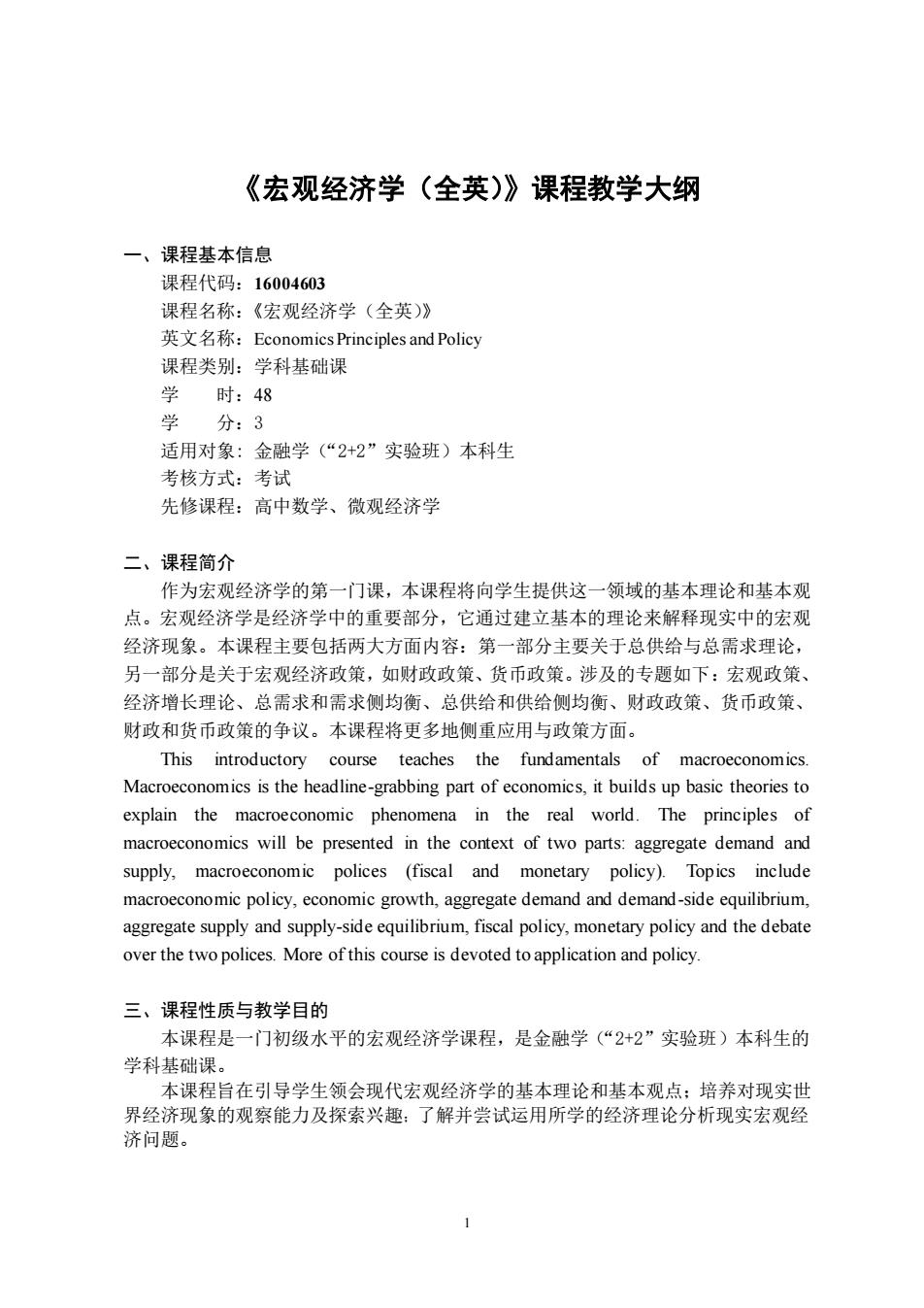
《宏观经济学(全英)》课程教学大纲 一、课程基本信息 课程代码:16004603 课程名称:《宏观经济学(全英)》 英文名称:Economics Principles and Policy 课程类别:学科基础课 时:48 学分:3 适用对象:金融学(“2+2”实验班)本科生 考核方式:考试 先修课程:高中数学、微观经济学 二、课程简介 作为宏观经济学的第一门课,本课程将向学生提供这一领域的基本理论和基本观 点。宏观经济学是经济学中的重要部分,它通过建立基本的理论来解释现实中的宏观 经济现象。本课程主要包括两大方面内容:第一部分主要关于总供给与总需求理论, 另一部分是关于宏观经济政策,如财政政策、货币政策。涉及的专题如下:宏观政策、 经济增长理论、总需求和需求侧均衡、总供给和供给侧均衡、财政政策、货币政策、 财政和货币政策的争议。本课程将更多地侧重应用与政策方面。 This introductory course teaches the fundamentals of macroeconomics Macroeconomics is the headline-grabbing part of economics,it builds up basic theories to explain the macroeconomic phenomena in the real world.The principles of macroeconomics will be presented in the context of two parts:aggregate demand and supply,macroeconomic polices (fiscal and monetary policy).Topics include macroeconomic policy,economic growth,aggregate demand and demand-side equilibrium, aggregate supply and supply-sideequilibrium,fiscal policy.monetary policy and the debate over the two polices.More of this course is devoted to application and policy. 三、课程性质与教学目的 本课程是一门初级水平的宏观经济学课程,是金融学(“2+2”实验班)本科生的 学科基础课。 本课程旨在引导学生领会现代宏观经济学的基本理论和基本观点:培养对现实世 界经济现象的观察能力及探索兴趣:了解并尝试运用所学的经济理论分析现实宏观经 济问题
1 《宏观经济学(全英)》课程教学大纲 一、课程基本信息 课程代码:16004603 课程名称:《宏观经济学(全英)》 英文名称:Economics Principles and Policy 课程类别:学科基础课 学 时:48 学 分:3 适用对象: 金融学(“2+2”实验班)本科生 考核方式:考试 先修课程:高中数学、微观经济学 二、课程简介 作为宏观经济学的第一门课,本课程将向学生提供这一领域的基本理论和基本观 点。宏观经济学是经济学中的重要部分,它通过建立基本的理论来解释现实中的宏观 经济现象。本课程主要包括两大方面内容:第一部分主要关于总供给与总需求理论, 另一部分是关于宏观经济政策,如财政政策、货币政策。涉及的专题如下:宏观政策、 经济增长理论、总需求和需求侧均衡、总供给和供给侧均衡、财政政策、货币政策、 财政和货币政策的争议。本课程将更多地侧重应用与政策方面。 This introductory course teaches the fundamentals of macroeconomics. Macroeconomics is the headline-grabbing part of economics, it builds up basic theories to explain the macroeconomic phenomena in the real world. The principles of macroeconomics will be presented in the context of two parts: aggregate demand and supply, macroeconomic polices (fiscal and monetary policy). Topics include macroeconomic policy, economic growth, aggregate demand and demand-side equilibrium, aggregate supply and supply-side equilibrium, fiscal policy, monetary policy and the debate over the two polices. More of this course is devoted to application and policy. 三、课程性质与教学目的 本课程是一门初级水平的宏观经济学课程,是金融学(“2+2”实验班)本科生的 学科基础课。 本课程旨在引导学生领会现代宏观经济学的基本理论和基本观点;培养对现实世 界经济现象的观察能力及探索兴趣;了解并尝试运用所学的经济理论分析现实宏观经 济问题
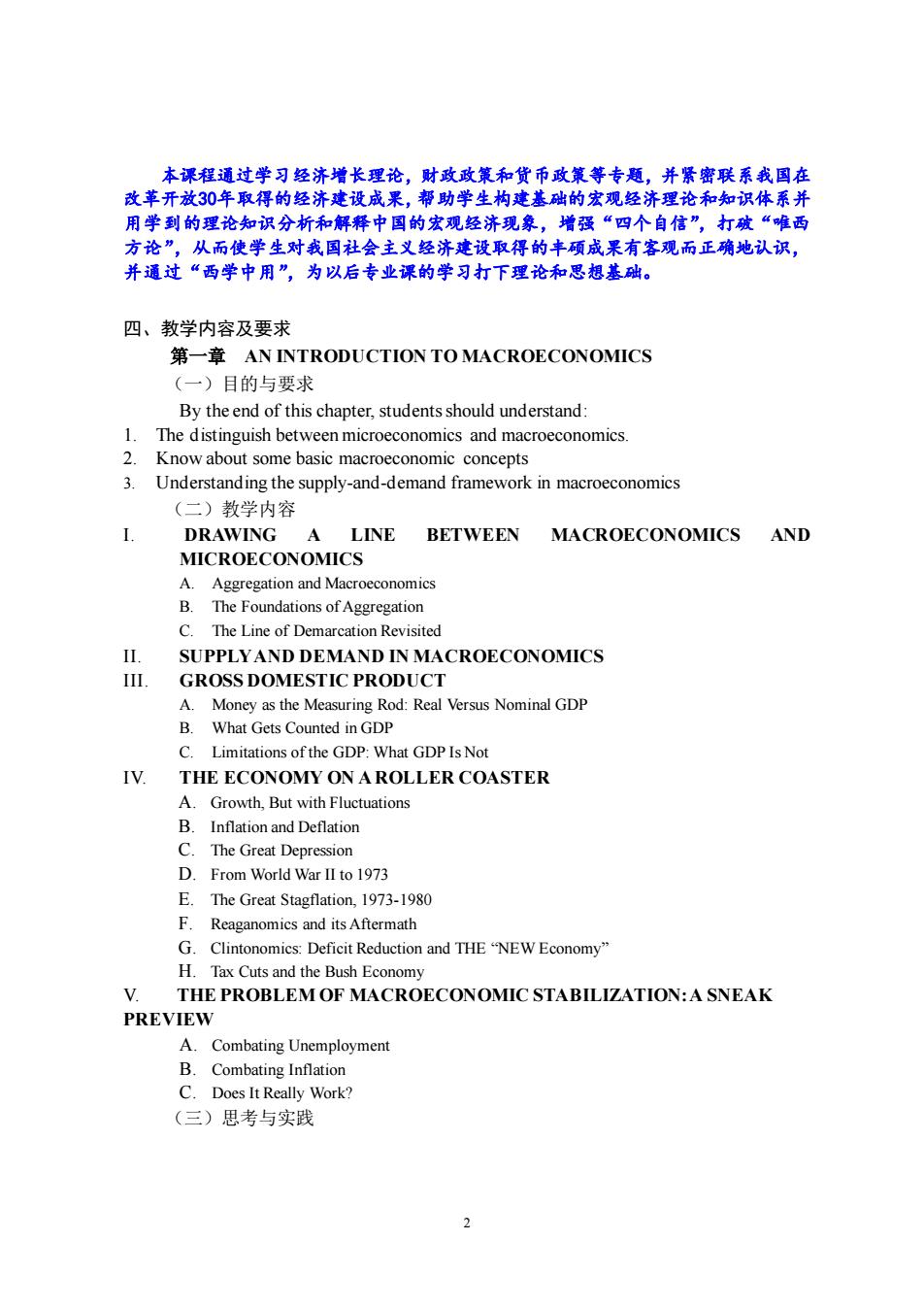
本课程通过学习经济增长理论,财政政策和货币政策等专题,并紧密联系我国在 改革开放30年取得的经济建设成果,帮助学生构建基础的宏观经济理论和知识体系并 用学到的理论知识分析和解释中国的宏观经济现象,增强“四个自信”,打破“唯西 方论”,从而使学生对我国社会主义经济建设取得的丰硕成果有客观而正确地认识, 并通过“西学中用”,为以后专业课的学习打下理论和思想基础。 四、教学内容及要求 第-章AN INTRODUCTION TO MACROECONOMICS (一)目的与要求 By the end of this chapter students should understand 1.The distinguish between microeconomics and macroeconomics. 2.Know about some basic macroeconomic concepts 3.Understanding the supply-and-demand frame ork in macroeconomics (二)教学内容 DRAWING BETWEEN MACROECONOMICS AnD MICROECONOMICS II. SUPPLYAND DEMAND IN MACROECONOMICS . GROSS DOMESTIC PRODUCT Money as the Measu What Gets Counted Limitations of the GDP:What GDP Is Not IV THE ECONOMY ON AROLLER COASTER A.Growth.But with Fluctuations B The Great De From World War II to 1973 E The Great Stagflation 1973-1980 F.Reaganomics and its Aftermath G Clintonomies:Deficit Reduction nand THE "NEW Economy' d th Bush ec THE PROBLEM OF ROECONOMIC STABILIZATION:A SNEAK PREVIEW A.Combating Unemployment B Combating Inflat It R lly Work? (三)思考与实践
2 本课程通过学习经济增长理论,财政政策和货币政策等专题,并紧密联系我国在 改革开放30年取得的经济建设成果,帮助学生构建基础的宏观经济理论和知识体系并 用学到的理论知识分析和解释中国的宏观经济现象,增强“四个自信”,打破“唯西 方论”,从而使学生对我国社会主义经济建设取得的丰硕成果有客观而正确地认识, 并通过“西学中用”,为以后专业课的学习打下理论和思想基础。 四、教学内容及要求 第一章 AN INTRODUCTION TO MACROECONOMICS (一)目的与要求 By the end of this chapter, students should understand: 1. The distinguish between microeconomics and macroeconomics. 2. Know about some basic macroeconomic concepts 3. Understanding the supply-and-demand framework in macroeconomics (二)教学内容 I. DRAWING A LINE BETWEEN MACROECONOMICS AND MICROECONOMICS A. Aggregation and Macroeconomics B. The Foundations of Aggregation C. The Line of Demarcation Revisited II. SUPPLY AND DEMAND IN MACROECONOMICS III. GROSS DOMESTIC PRODUCT A. Money as the Measuring Rod: Real Versus Nominal GDP B. What Gets Counted in GDP C. Limitations of the GDP: What GDP Is Not IV. THE ECONOMY ON A ROLLER COASTER A. Growth, But with Fluctuations B. Inflation and Deflation C. The Great Depression D. From World War II to 1973 E. The Great Stagflation, 1973-1980 F. Reaganomics and its Aftermath G. Clintonomics: Deficit Reduction and THE “NEW Economy” H. Tax Cuts and the Bush Economy V. THE PROBLEM OF MACROECONOMIC STABILIZATION: A SNEAK PREVIEW A. Combating Unemployment B. Combating Inflation C. Does It Really Work? (三)思考与实践
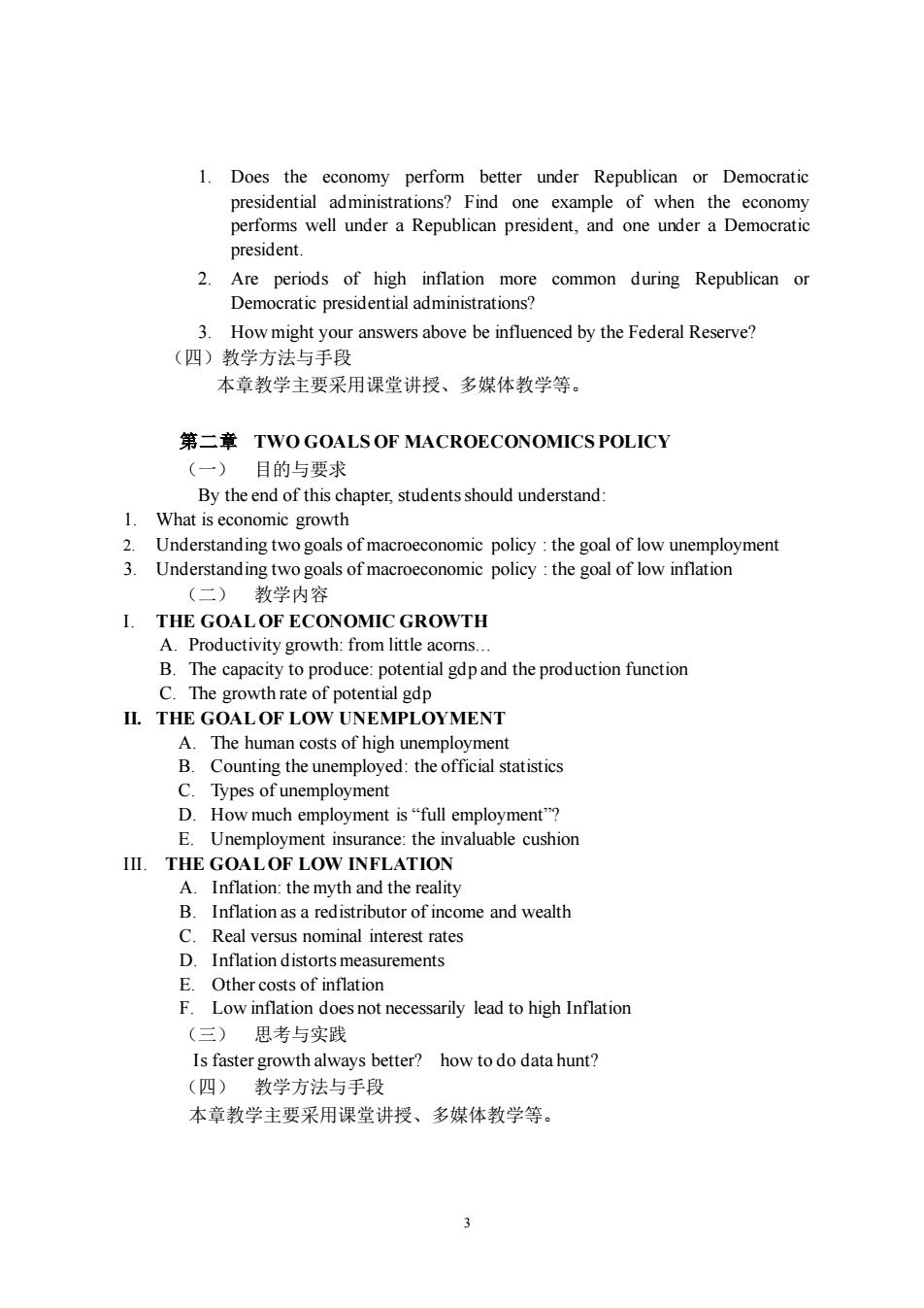
1.Does the economy perform better under Republican or Democratic presidential administrations?Find one example of when the economy performs well under a Republican president,and one under a Democratic 2.Are periods of high inflation more common during Republican or Democratic presidential administrations? 3.How might your answers above be influenced by the federal reserve? (四)教学方法与手段 本章教学主要采用课堂讲授、多媒体教学等。 第二章TWO GOALS OF MACROECONOMICS POLICY (一)目的与要求 By the end of this chapter,students should understand 1.What is economic growth 2.Understanding two goals of macroeconomic policy the goal of low unemployment 3.Understanding two goals of macroeconomic policy:the goal of low inflation 教学内容 I.THE GOALOF ECONOMIC GROWTH A.Productivity growth:from little acorns. B.The capacity to produce:potential gdpand the production function The growt of pot % IL.THE GOALOF LOW UNEMPLOYMENT A.The human costs of high unemployment B.Counting the unemployed:the official statistics C.Types of unemployment D Ho much emp loyment is"full yment ployment the invaluable cushio III.THE GOALOF LOW INFLATION A.Inflation:the myth and the reality b.Inflation as a redistributor of income and wealth Real versus nominal inter rest rates nea urement: Other costs of inflation f low inflation does not necessarily lead to high inflation (三)思考与实我 Is faster growth always better? how to do data hunt? (四)教学方法与手段 本章教学主要采用课堂讲授、多媒体教学等 3
3 1. Does the economy perform better under Republican or Democratic presidential administrations? Find one example of when the economy performs well under a Republican president, and one under a Democratic president. 2. Are periods of high inflation more common during Republican or Democratic presidential administrations? 3. How might your answers above be influenced by the Federal Reserve? (四)教学方法与手段 本章教学主要采用课堂讲授、多媒体教学等。 第二章 TWO GOALS OF MACROECONOMICS POLICY (一) 目的与要求 By the end of this chapter, students should understand: 1. What is economic growth 2. Understanding two goals of macroeconomic policy : the goal of low unemployment 3. Understanding two goals of macroeconomic policy : the goal of low inflation (二) 教学内容 I. THE GOAL OF ECONOMIC GROWTH A. Productivity growth: from little acorns… B. The capacity to produce: potential gdp and the production function C. The growth rate of potential gdp II. THE GOAL OF LOW UNEMPLOYMENT A. The human costs of high unemployment B. Counting the unemployed: the official statistics C. Types of unemployment D. How much employment is “full employment”? E. Unemployment insurance: the invaluable cushion III. THE GOAL OF LOW INFLATION A. Inflation: the myth and the reality B. Inflation as a redistributor of income and wealth C. Real versus nominal interest rates D. Inflation distorts measurements E. Other costs of inflation F. Low inflation does not necessarily lead to high Inflation (三) 思考与实践 Is faster growth always better? how to do data hunt? (四) 教学方法与手段 本章教学主要采用课堂讲授、多媒体教学等
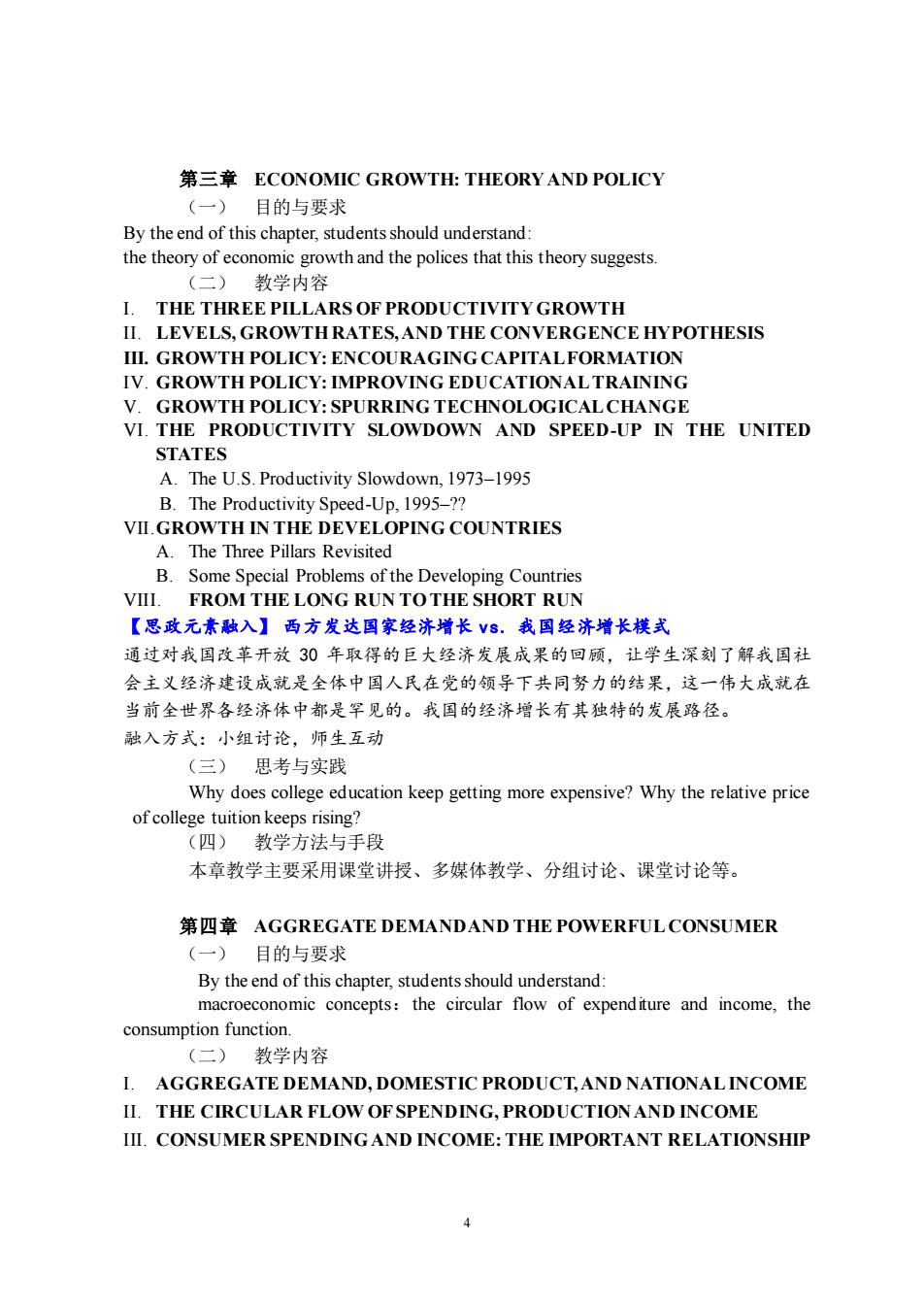
第三章ECONOMIC GROWTH:THEORY AND POLICY 目的与要求 By the end of this chapter,students should understand: the theory of economic growth and the polices that this theory suggests. (一) 教学内容 I.THE THREE PILLARS OF PRODUCTIVITY GROWTH IL LEVELS.GROWTHRATES.AND THE CONVERGENCE HYPOTHESIS IIL.GROWTH POLICY:ENCOURAGING CAPITALFORMATION IV.GROWTH POLICY:IMPROVING EDUCATIONALTRAINING GROWTH POLICY: SPURRING TEC CHNOLOGICALCHANGE VI.THE PRODUCTIVITY SLOWDOWN AND SPEED-UP IN THE UNITED STATES A.The U.S.Productivity Slowdown.1973-1995 B The Productivity Speed-Un 1995-?? VII.GROWTH IN THE DEVELOPING COUNTRIES Three Pillars Revisited B.Some Special Problems of the Developing Countrie VIII.FROM THE LONG RUN TOTHE SHORT RUN 【思政元素融入】西方发达国家经济增长s.我国经济增长模式 通过对我国改革开放30年取得的巨大经济发展成果的回顾,让学生深刻了解我国社 会主义经济建设成就是全体中国人民在党的领导下共同努力的结果,这一伟大成就在 当前全世界各经济体中都是罕见的。我国的经济增长有其独特的发展路径。 融入方式:小组讨论,师生互动 (三)思考与实我 Why does college education keep getting more expensive?Why the relative price eeps rising (四) 教学方法与手段 本章教学主要采用课堂讲授、多媒体教学、分组讨论、课堂讨论等 第四章AGGREGATE DEMANDAND THE POWERFUL CONSUMER (一) 目的与要求 By the end of this chapter.students should understand: concepts:the e circular flow of expendture and income,the consumption function. (二)教学内容 I.AGGREGATE DEMAND,DOMESTIC PRODUCT,AND NATIONALINCOME II.THE CIRCULAR FLOW OFSPENDING,PRODUCTION AND INCOME III.CONSUMER SPENDING AND INCOME:THE IMPORTANT RELATIONSHIP 4
4 第三章 ECONOMIC GROWTH: THEORY AND POLICY (一) 目的与要求 By the end of this chapter, students should understand: the theory of economic growth and the polices that this theory suggests. (二) 教学内容 I. THE THREE PILLARS OF PRODUCTIVITY GROWTH II. LEVELS, GROWTH RATES, AND THE CONVERGENCE HYPOTHESIS III. GROWTH POLICY: ENCOURAGING CAPITAL FORMATION IV. GROWTH POLICY: IMPROVING EDUCATIONAL TRAINING V. GROWTH POLICY: SPURRING TECHNOLOGICAL CHANGE VI. THE PRODUCTIVITY SLOWDOWN AND SPEED-UP IN THE UNITED STATES A. The U.S. Productivity Slowdown, 1973–1995 B. The Productivity Speed-Up, 1995–?? VII.GROWTH IN THE DEVELOPING COUNTRIES A. The Three Pillars Revisited B. Some Special Problems of the Developing Countries VIII. FROM THE LONG RUN TO THE SHORT RUN 【思政元素融入】 西方发达国家经济增长 vs. 我国经济增长模式 通过对我国改革开放 30 年取得的巨大经济发展成果的回顾,让学生深刻了解我国社 会主义经济建设成就是全体中国人民在党的领导下共同努力的结果,这一伟大成就在 当前全世界各经济体中都是罕见的。我国的经济增长有其独特的发展路径。 融入方式:小组讨论,师生互动 (三) 思考与实践 Why does college education keep getting more expensive? Why the relative price of college tuition keeps rising? (四) 教学方法与手段 本章教学主要采用课堂讲授、多媒体教学、分组讨论、课堂讨论等。 第四章 AGGREGATE DEMAND AND THE POWERFUL CONSUMER (一) 目的与要求 By the end of this chapter, students should understand: macroeconomic concepts:the circular flow of expenditure and income, the consumption function. (二) 教学内容 I. AGGREGATE DEMAND, DOMESTIC PRODUCT, AND NATIONAL INCOME II. THE CIRCULAR FLOW OF SPENDING, PRODUCTION AND INCOME III. CONSUMER SPENDING AND INCOME: THE IMPORTANT RELATIONSHIP
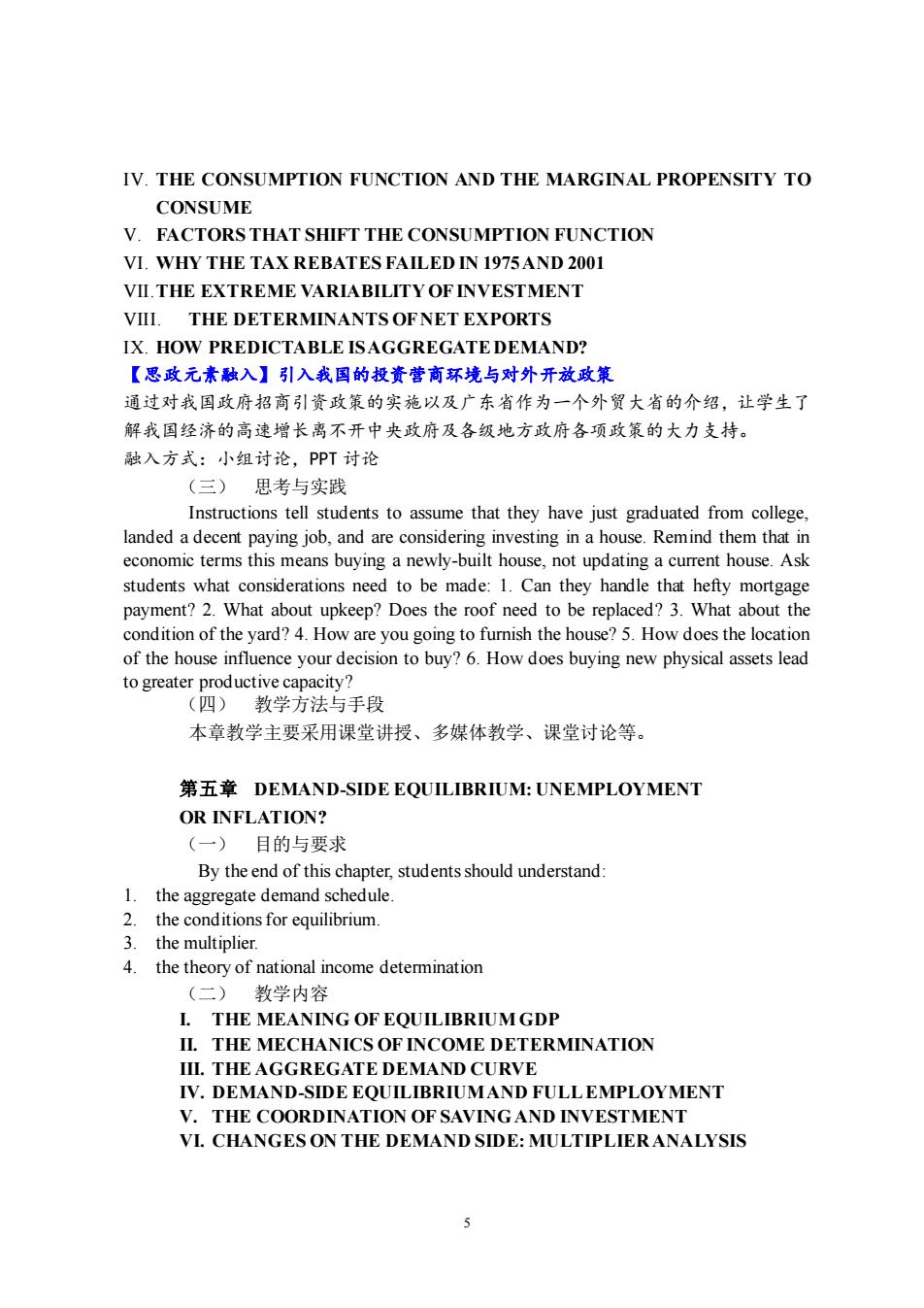
IV.THE CONSUMPTION FUNCTION AND THE MARGINAL PROPENSITY TO CONSUME V.FACTORS THAT SHIFT THE CONSUMPTION FUNCTION VI.WHY THE TAX REBATES FAILED IN 1975AND 2001 VIL THE EXTREME VARIABILITY OFINVESTMENT THE DETERMINANTS OFNET EXPORTS IX HOW PREDICTABLE ISAGGREGATEDEMAND? 【思政元素融入】引入我国的校资曹商环境与对外开放政策 通过对我国政府招商引资政策的实施以及广东省作为一个外贸大省的介绍,让学生了 解我国经济的高速增长离不开中央政府及各级地方政府各项政策的大力支持。 融入方式:小组讨论,PPT讨论 (三) 思考与实践 Instructions tell students to assume that they have just graduated from college landed a decent ting in a h e.Remind th em thar t updat current house Ask students what considerations need to be made:1.Can they handle that hefty mortgage payment?2.What about upkeep?Does the roof need to be replaced?3.What about the condition of the yard?4.How are you going to furnish the house?5.How does the location of the house influence your decision to buy?6.How does buying new physical assets lead to greater 四) 教学法与手段 本章教学主要采用课堂讲授、多媒体教学、课堂讨论等 第五章DEMAND-SIDE EQUILIBRIUM:UNEMPLOYMENT OR INFLATION? (一)目的与要求 By the end of this chapter,students should understand the aggregate de emand schedule 2.the conditions for equilibrium. 3.the multiplier. 4.the theory of national income determination (二) 教学内容 L THE MEANING OF EOUILIBRIUMGDP IL.THE MECHANICS OF INCOME DETERMINATION IIL THE AGGREGATE DEMAND CURVE V.DEMAND-SIDE EQUILIBRIUMAND FULLEMPLOYMENT THE COORDINATION OF SAVING AND INVESTMENT VI.CHANGES ON THE DEMAND SIDE:MULTIPLIER ANALYSIS 5
5 IV. THE CONSUMPTION FUNCTION AND THE MARGINAL PROPENSITY TO CONSUME V. FACTORS THAT SHIFT THE CONSUMPTION FUNCTION VI. WHY THE TAX REBATES FAILED IN 1975 AND 2001 VII.THE EXTREME VARIABILITY OF INVESTMENT VIII. THE DETERMINANTS OF NET EXPORTS IX. HOW PREDICTABLE IS AGGREGATE DEMAND? 【思政元素融入】引入我国的投资营商环境与对外开放政策 通过对我国政府招商引资政策的实施以及广东省作为一个外贸大省的介绍,让学生了 解我国经济的高速增长离不开中央政府及各级地方政府各项政策的大力支持。 融入方式:小组讨论,PPT 讨论 (三) 思考与实践 Instructions tell students to assume that they have just graduated from college, landed a decent paying job, and are considering investing in a house. Remind them that in economic terms this means buying a newly-built house, not updating a current house. Ask students what considerations need to be made: 1. Can they handle that hefty mortgage payment? 2. What about upkeep? Does the roof need to be replaced? 3. What about the condition of the yard? 4. How are you going to furnish the house? 5. How does the location of the house influence your decision to buy? 6. How does buying new physical assets lead to greater productive capacity? (四) 教学方法与手段 本章教学主要采用课堂讲授、多媒体教学、课堂讨论等。 第五章 DEMAND-SIDE EQUILIBRIUM: UNEMPLOYMENT OR INFLATION? (一) 目的与要求 By the end of this chapter, students should understand: 1. the aggregate demand schedule. 2. the conditions for equilibrium. 3. the multiplier. 4. the theory of national income determination (二) 教学内容 I. THE MEANING OF EQUILIBRIUM GDP II. THE MECHANICS OF INCOME DETERMINATION III. THE AGGREGATE DEMAND CURVE IV. DEMAND-SIDE EQUILIBRIUM AND FULL EMPLOYMENT V. THE COORDINATION OF SAVING AND INVESTMENT VI. CHANGES ON THE DEMAND SIDE: MULTIPLIER ANALYSIS
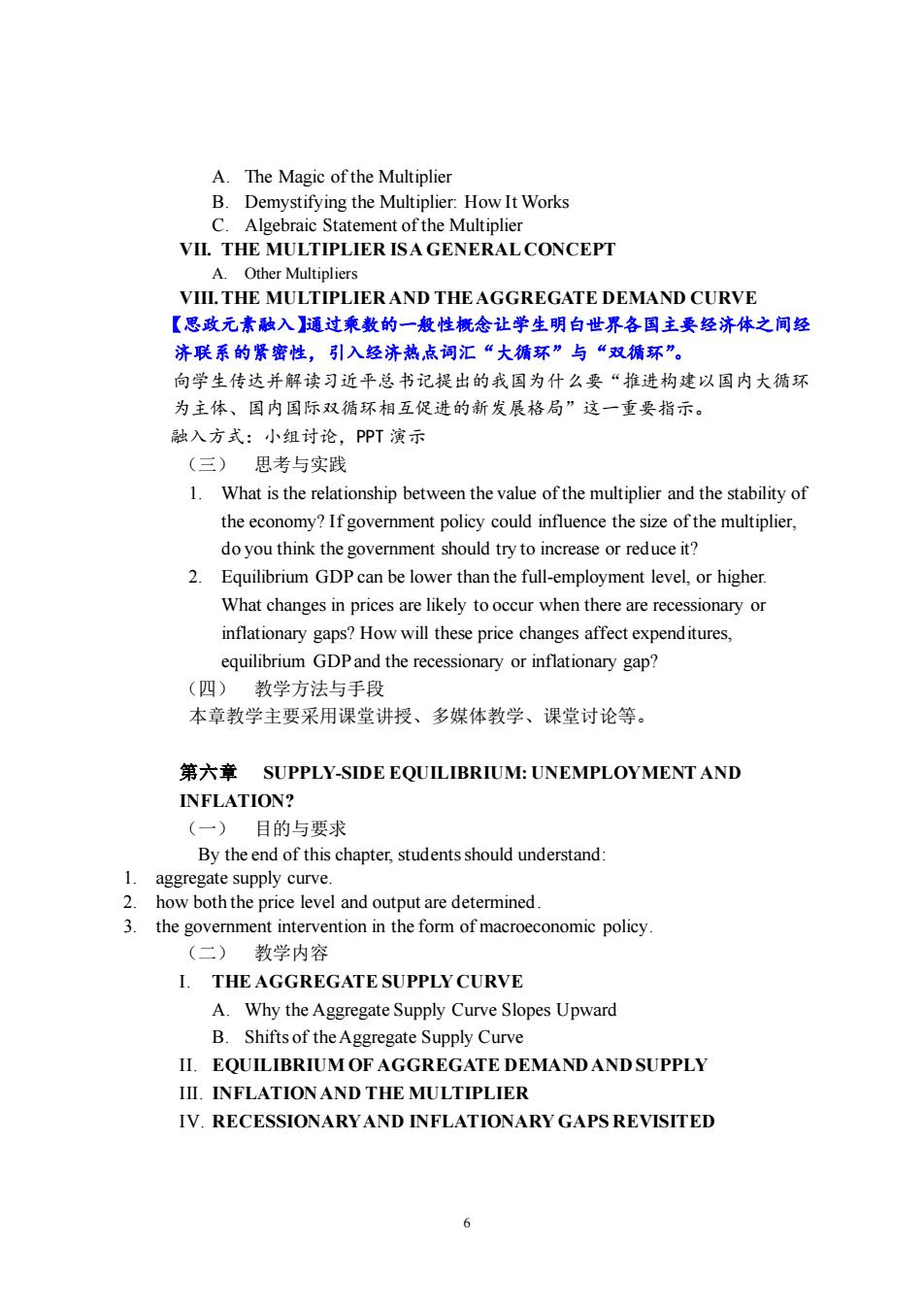
A.The Magic of the Multiplier B.Demystifying the Multiplier.How It Works C.Algebraic Statement of the Multiplier VIL.THE MULTIPLIER ISA GENERAL CONCEPT VIIL.THE MULTIPLIERAND THEAGGREGATE DEMAND CURVE 【思政元素融入】通过乘教的一般性概念让学生明白世界各国主要经济体之间经 济联系的紧密性,引入经济热点词汇“大循环”与“双循环”。 向学生传达并解读习近平总书记提出的我国为什么要“推进构建以国内大循环 为主体、国内国际双循环相互促进的新发展格局”这一重要指示。 融入方式:小组讨论,PPT演示 (三) 思考与实践 1.What is the relationship between the value of the multiplier and the stability of the economy?If government policy could influence the size of the multiplier, do you think the govemment should try to increase or reduce it? 2.Equilibrium GDP can be lower than the full-employment level,or higher What changes in prices are likely to occur when there are recessionary or inflationary gaps?How will these price changes affect expenditures, equilibrium GDPand the recessionary or inflationary gap? (四)教学方法与手段 本章教学主要采用课堂讲授、多媒体教学、课堂讨论等 第六章 SUPPLY-SIDE EQUILIBRIUM:UNEMPLOYMENT AND INFLATION? (一)目的与要求 By the end of this chapter,students should understand 1 aggregate supply curve 2.how both the price level and output are determined 3.the governm t intervention in the form of macroeconomic policy (二) 教学内容 I.THEAGGREGATE SUPPLY CURVE A.Why the Aggregate Supply Curve Slopes Upward B.Shiftsof the Aggregate Supply Curve II.EQUILIBRIUM OF AGGREGATE DEMAND AND SUPPLY III.INFLATION AND THE MULTIPLIER IV.RECESSIONARYAND INFLATIONARY GAPS REVISITED 6
6 A. The Magic of the Multiplier B. Demystifying the Multiplier: How It Works C. Algebraic Statement of the Multiplier VII. THE MULTIPLIER IS A GENERAL CONCEPT A. Other Multipliers VIII.THE MULTIPLIER AND THE AGGREGATE DEMAND CURVE 【思政元素融入】通过乘数的一般性概念让学生明白世界各国主要经济体之间经 济联系的紧密性,引入经济热点词汇“大循环”与“双循环”。 向学生传达并解读习近平总书记提出的我国为什么要“推进构建以国内大循环 为主体、国内国际双循环相互促进的新发展格局”这一重要指示。 融入方式:小组讨论,PPT 演示 (三) 思考与实践 1. What is the relationship between the value of the multiplier and the stability of the economy? If government policy could influence the size of the multiplier, do you think the government should try to increase or reduce it? 2. Equilibrium GDP can be lower than the full-employment level, or higher. What changes in prices are likely to occur when there are recessionary or inflationary gaps? How will these price changes affect expenditures, equilibrium GDP and the recessionary or inflationary gap? (四) 教学方法与手段 本章教学主要采用课堂讲授、多媒体教学、课堂讨论等。 第六章 SUPPLY-SIDE EQUILIBRIUM: UNEMPLOYMENT AND INFLATION? (一) 目的与要求 By the end of this chapter, students should understand: 1. aggregate supply curve. 2. how both the price level and output are determined. 3. the government intervention in the form of macroeconomic policy. (二) 教学内容 I. THE AGGREGATE SUPPLY CURVE A. Why the Aggregate Supply Curve Slopes Upward B. Shifts of the Aggregate Supply Curve II. EQUILIBRIUM OF AGGREGATE DEMAND AND SUPPLY III. INFLATION AND THE MULTIPLIER IV. RECESSIONARY AND INFLATIONARY GAPS REVISITED
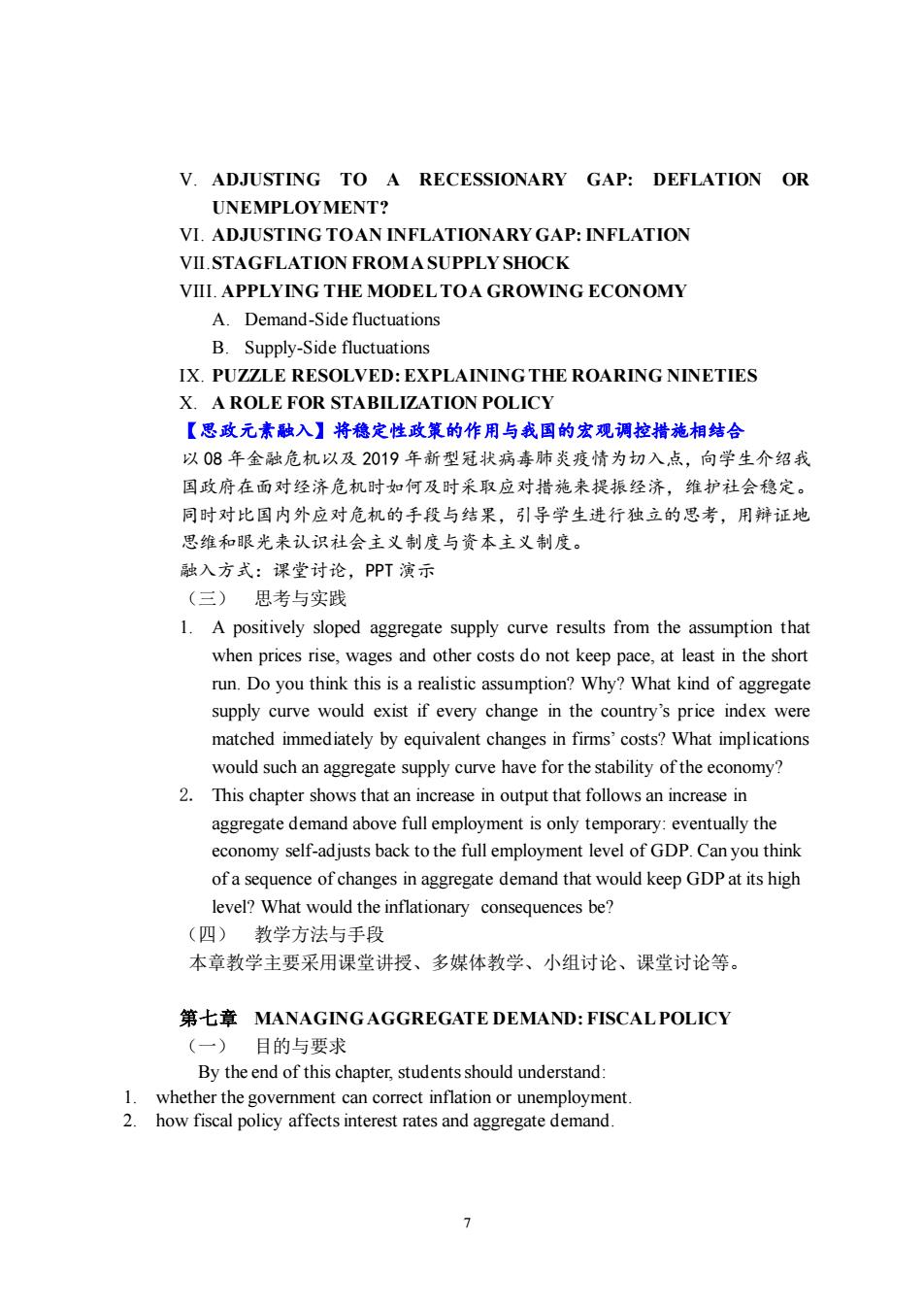
V.ADJUSTING TO A RECESSIONARY GAP:DEFLATION OR UNEMPLOYMENT? VI.ADJUSTING TOAN INFLATIONARY GAP:INFLATION VIL.STAGFLATION FROMASUPPLY SHOCK VIIL APPLYING THE MODELTOA GROWING ECONOMY A.Demand-Side fluctuations B.Supply-Side fluctuations IX.PUZZLE RESOLVED:EXPLAINING THE ROARING NINETIES X.A ROLE FOR STABILIZATION POLICY 【思政元素融入】将稳定性政策的作用与我国的宏观调控措施相结合 以08年金融危机以及2019年新型冠状病毒肺炎疫情为切入点,向学生介绍我 国政府在面对经济危机时如何及时采取应对措施来提振经济,维护社会稳定。 同时对比国内外应对危机的手段与结果,引导学生进行独立的思考,用辩证地 思维和眼光来认识社会主义制度与资本主义制度。 融入方式:课堂讨论,PPT演示 (三)思考与实我 1.A positively sloped aggregate supply curve results from the assumption that when prices rise.wages and other costs do not keep pace.at least in the short run.Do you think this is a realistic assumption?Why?What kind of aggregate supply curve would exist if every change in the country's price index were matched immediately by equivalent changes in firms'costs?What implications would such an aggregate supply curve have for the stability of the economy? 2. This chapter shows that an increase in output that follows an increase in aggregate demand above full employment is only temporary:eventually the economy self-adjusts back to the full employment level of GDP.Can you think ofa sequence of changes in aggregate demand that would keep GDP at its high level?What would the inflationary consequences be? (四)教学方法与手段 本章教学主要采用课堂讲授、多媒体教学、小组讨论、课堂讨论等。 第七章MANAGINGAGGREGATE DEMAND:FISCAL POLICY (一)目的与要求 By the end of this chapter,students should understand 1.whether the government can correct inflation or unemployment 2.how fiscal policy affects interest rates and aggregate demand
7 V. ADJUSTING TO A RECESSIONARY GAP: DEFLATION OR UNEMPLOYMENT? VI. ADJUSTING TO AN INFLATIONARY GAP: INFLATION VII.STAGFLATION FROM A SUPPLY SHOCK VIII. APPLYING THE MODEL TO A GROWING ECONOMY A. Demand-Side fluctuations B. Supply-Side fluctuations IX. PUZZLE RESOLVED: EXPLAINING THE ROARING NINETIES X. A ROLE FOR STABILIZATION POLICY 【思政元素融入】将稳定性政策的作用与我国的宏观调控措施相结合 以 08 年金融危机以及 2019 年新型冠状病毒肺炎疫情为切入点,向学生介绍我 国政府在面对经济危机时如何及时采取应对措施来提振经济,维护社会稳定。 同时对比国内外应对危机的手段与结果,引导学生进行独立的思考,用辩证地 思维和眼光来认识社会主义制度与资本主义制度。 融入方式:课堂讨论,PPT 演示 (三) 思考与实践 1. A positively sloped aggregate supply curve results from the assumption that when prices rise, wages and other costs do not keep pace, at least in the short run. Do you think this is a realistic assumption? Why? What kind of aggregate supply curve would exist if every change in the country’s price index were matched immediately by equivalent changes in firms’ costs? What implications would such an aggregate supply curve have for the stability of the economy? 2. This chapter shows that an increase in output that follows an increase in aggregate demand above full employment is only temporary: eventually the economy self-adjusts back to the full employment level of GDP. Can you think of a sequence of changes in aggregate demand that would keep GDP at its high level? What would the inflationary consequences be? (四) 教学方法与手段 本章教学主要采用课堂讲授、多媒体教学、小组讨论、课堂讨论等。 第七章 MANAGING AGGREGATE DEMAND: FISCAL POLICY (一) 目的与要求 By the end of this chapter, students should understand: 1. whether the government can correct inflation or unemployment. 2. how fiscal policy affects interest rates and aggregate demand

(一)教学内容 I.INCOME TAXESAND THE CONSUMPTION SCHEDULE IL.THE MULTIPLIER REVISITED A.The Tax Multiplier B.Income Taxes and the Multiplier C.Automatic Stabilizers D.Government Transfer Payments III.PLANNING EXPANSIONARY FISCAL POLICY IV.PLANNING CONTRACTIONARY FISCAL POLICY V.THE CHOICE BETWEEN SPENDING POLICY AND TAX POLICY VI.SOME HARSH REALITIES VI.THE IDEA BEHIND SUPPLY-SIDE TAX CUTS A.Some Flies in the Ointment B.Toward Assessment of Supply-Side Economics 【思政元素融入】结合时事,讲解我国的一系列财政政策 让学生应用所学的理论知识,解读财政部实施的财政政策。 融入方式:课堂讨论,PPT演示 (三)思考与实我 1. Because it is worried about inflation in the future,the goverment has decided to restrict aggregate demand.Which tool of fiscal policy (or combination)do you believe it should use:goverment purchases.taxes or transfers?Why? 2.Some supply-side proponents argue that income taxes are so high that they discourage people from working and earning income.How plausible do you think this view is? (四)教学方法与手段 本章教学主要采用课堂讲授、多媒体教学、小组讨论、课堂讨论等。 第八章MONEY AND THE BANKING SYSTEM (一) 目的与要求 By the end of this chapter,students should understand: 1.what money is and what functions money has in the economy 2.how the banking system helps determine the supply of money 教学内容 I.THE NATURE OF MONEY A.Barter versus monetary exchange
8 (二) 教学内容 I. INCOME TAXES AND THE CONSUMPTION SCHEDULE II. THE MULTIPLIER REVISITED A. The Tax Multiplier B. Income Taxes and the Multiplier C. Automatic Stabilizers D. Government Transfer Payments III. PLANNING EXPANSIONARY FISCAL POLICY IV. PLANNING CONTRACTIONARY FISCAL POLICY V. THE CHOICE BETWEEN SPENDING POLICY AND TAX POLICY VI. SOME HARSH REALITIES VII. THE IDEA BEHIND SUPPLY-SIDE TAX CUTS A. Some Flies in the Ointment B. Toward Assessment of Supply-Side Economics 【思政元素融入】结合时事,讲解我国的一系列财政政策 让学生应用所学的理论知识,解读财政部实施的财政政策。 融入方式:课堂讨论,PPT 演示 (三) 思考与实践 1. Because it is worried about inflation in the future, the government has decided to restrict aggregate demand. Which tool of fiscal policy (or combination) do you believe it should use: government purchases, taxes or transfers? Why? 2. Some supply-side proponents argue that income taxes are so high that they discourage people from working and earning income. How plausible do you think this view is? (四) 教学方法与手段 本章教学主要采用课堂讲授、多媒体教学、小组讨论、课堂讨论等。 第八章 MONEY AND THE BANKING SYSTEM (一) 目的与要求 By the end of this chapter, students should understand: 1. what money is and what functions money has in the economy. 2. how the banking system helps determine the supply of money. (二) 教学内容 I. THE NATURE OF MONEY A. Barter versus monetary exchange
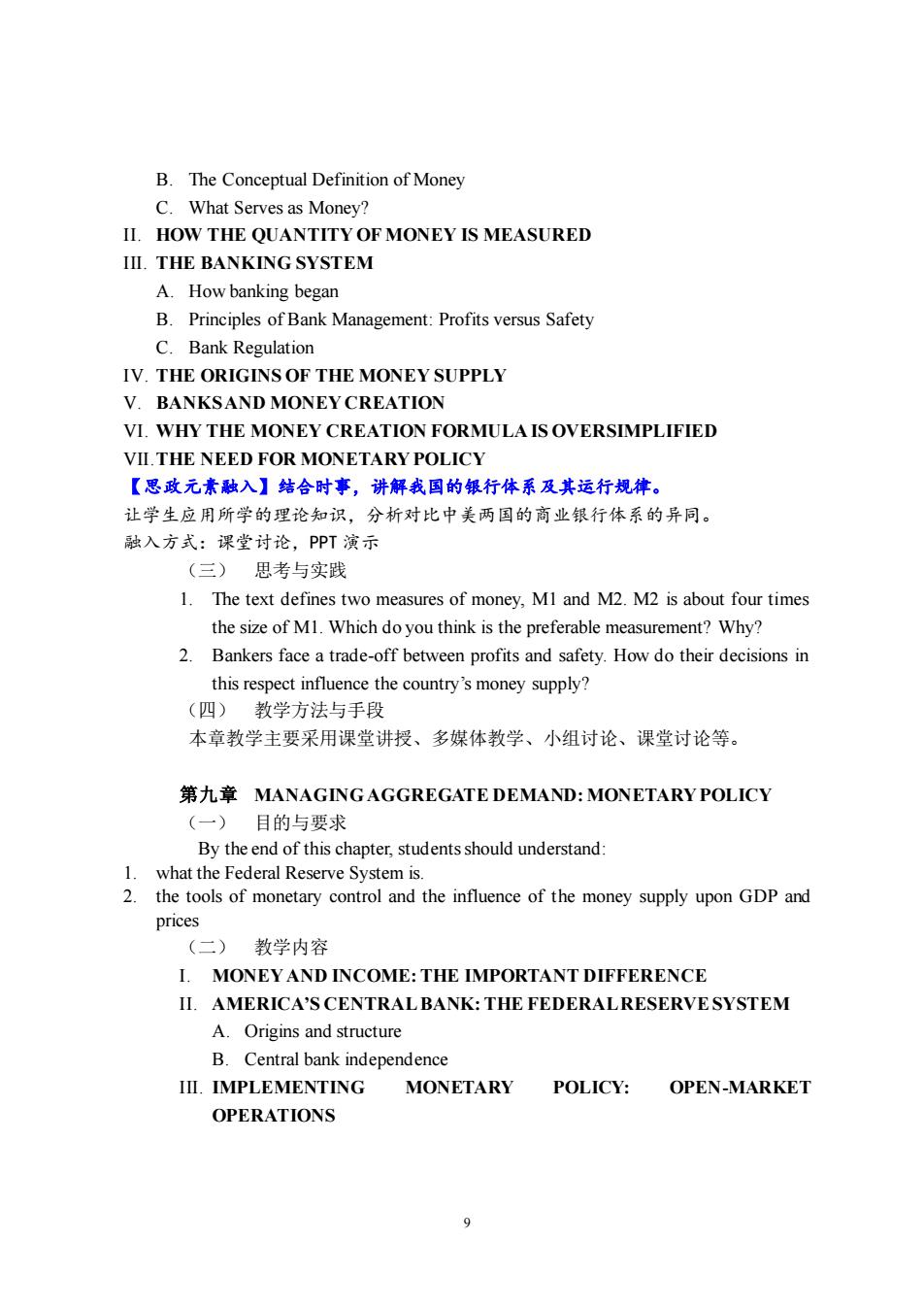
B.The Conceptual Definition of Money C.What Serves as Money? II.HOW THE QUANTITY OF MONEY IS MEASURED III.THE BANKING SYSTEM A.How banking began B.Principles of Bank Management:Profits versus Safety C.Bank Regulation IV.THE ORIGINS OF THE MONEY SUPPLY V BANKSAND MONEY CREATION VI.WHY THE MONEY CREATION FORMULA IS OVERSIMPLIFIED VII.THE NEED FOR MONETARY POLICY 【思政元素融入】结合时事,讲解我国的银行体系及其运行规律。 让学生应用所学的理论知识,分析对比中美两国的商业银行体系的异同。 融入方式:课堂讨论,PPT演示 (三)思考与实践 1.The text defines two measures of money,MI and M2.M2 is about four times the size of MI.Which doyou think is the preferable measurement?Why? 2.Bankers face a trade-off between profits and safety.How do their decisions in this respect influence the country's money supply? (四)教学方法与手段 本章教学主要采用课堂讲授、多媒体教学、小组讨论、课堂讨论等 第九章MANAGINGAGGREGATE DEMAND:MONETARY POLICY (一)目的与要求 By the what the Federal Reserve System is 2.the tools of monetary control and the influence of the money supply upon GDP and prices (二)教学内容 L MONEYAND INCOME:THE IMPORTANT DIFFERENCE II.AMERICA'S CENTRALBANK:THE FEDERALRESERVESYSTEM A.Origins and structure B.Central bank independence III.IMPLEMENTING MONETARY POLICY: OPEN-MARKET OPERATIONS 9
9 B. The Conceptual Definition of Money C. What Serves as Money? II. HOW THE QUANTITY OF MONEY IS MEASURED III. THE BANKING SYSTEM A. How banking began B. Principles of Bank Management: Profits versus Safety C. Bank Regulation IV. THE ORIGINS OF THE MONEY SUPPLY V. BANKS AND MONEY CREATION VI. WHY THE MONEY CREATION FORMULA IS OVERSIMPLIFIED VII.THE NEED FOR MONETARY POLICY 【思政元素融入】结合时事,讲解我国的银行体系及其运行规律。 让学生应用所学的理论知识,分析对比中美两国的商业银行体系的异同。 融入方式:课堂讨论,PPT 演示 (三) 思考与实践 1. The text defines two measures of money, M1 and M2. M2 is about four times the size of M1. Which do you think is the preferable measurement? Why? 2. Bankers face a trade-off between profits and safety. How do their decisions in this respect influence the country’s money supply? (四) 教学方法与手段 本章教学主要采用课堂讲授、多媒体教学、小组讨论、课堂讨论等。 第九章 MANAGING AGGREGATE DEMAND: MONETARY POLICY (一) 目的与要求 By the end of this chapter, students should understand: 1. what the Federal Reserve System is. 2. the tools of monetary control and the influence of the money supply upon GDP and prices (二) 教学内容 I. MONEY AND INCOME: THE IMPORTANT DIFFERENCE II. AMERICA’S CENTRAL BANK: THE FEDERAL RESERVE SYSTEM A. Origins and structure B. Central bank independence III. IMPLEMENTING MONETARY POLICY: OPEN-MARKET OPERATIONS

A.The Market for Bank Reserves B.The Mechanics of an Open Market Operation C.Open-Market Operations,Bond Prices,and Interest Rates IV.OTHER METHODS OF MONETARY CONTROL A.Lending to banks B.Changing reserve requirements V.HOW MONETARY POLICY WORKS A.Investment and Interest Rates B.Monetary Policy and Total Expenditure VL.MONEY AND THE PRICE LEVEL IN THE KEYNESIAN MODEL 【思政元素融入】结合时事,讲解我国的中央银行如何实施货币政篾 让学生应用所学的理论知识,解读我国央行的货币政策是如何实施的。 融入方式:课堂讨论,PPT演示 (三)思考与实践 1.Do you favor fractional reserve banking.or do you think deposits should be backed up on a 100 percent basis by reserves?What are the advantages and disadvantages of a 100 percent reserve system?Do you think bankers would fayor it? 2.The Fed has three basic tools that it can use to change the money supply open-market operations,changes in the banks'required reserve ratio and changes in policies regarding lending to member banks.Which do you think is the most useful,the least useful?Does the Fed really need three tools- wouldn't one dojust as well? (四)教学方法与手段 本章教学主要采用课堂讲授、多媒体教学、课堂讨论等 第十章THE DEBATE OVER MONETARYAND FISCALPOLICY (一)目的与要求 By the end of this chapter,students should understand: the quantity theory of money 2.how monetary policy affects interest rates and aggregate demand. 3.the debate over whether policymakers should try to stabilize the economy (二)教学内容 I.VELOCITYAND THE QUANTITYTHEORY OF MONEY A.Some Determinants of Velocity B.Monetarism:The Quantity Theory Modernized 10
10 A. The Market for Bank Reserves B. The Mechanics of an Open Market Operation C. Open-Market Operations, Bond Prices, and Interest Rates IV. OTHER METHODS OF MONETARY CONTROL A. Lending to banks B. Changing reserve requirements V. HOW MONETARY POLICY WORKS A. Investment and Interest Rates B. Monetary Policy and Total Expenditure VI. MONEY AND THE PRICE LEVEL IN THE KEYNESIAN MODEL 【思政元素融入】结合时事,讲解我国的中央银行如何实施货币政策。 让学生应用所学的理论知识,解读我国央行的货币政策是如何实施的。 融入方式:课堂讨论,PPT 演示 (三) 思考与实践 1. Do you favor fractional reserve banking, or do you think deposits should be backed up on a 100 percent basis by reserves? What are the advantages and disadvantages of a 100 percent reserve system? Do you think bankers would favor it? 2. The Fed has three basic tools that it can use to change the money supply: open-market operations, changes in the banks’ required reserve ratio and changes in policies regarding lending to member banks. Which do you think is the most useful, the least useful? Does the Fed really need three tools—wouldn’t one do just as well? (四) 教学方法与手段 本章教学主要采用课堂讲授、多媒体教学、课堂讨论等。 第十章 THE DEBATE OVER MONETARY AND FISCAL POLICY (一) 目的与要求 By the end of this chapter, students should understand: 1. the quantity theory of money. 2. how monetary policy affects interest rates and aggregate demand. 3. the debate over whether policymakers should try to stabilize the economy. (二) 教学内容 I. VELOCITY AND THE QUANTITY THEORY OF MONEY A. Some Determinants of Velocity B. Monetarism: The Quantity Theory Modernized